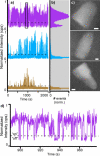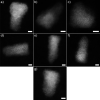Quantum Dot Fluorescent Imaging: Using Atomic Structure Correlation Studies to Improve Photophysical Properties
- PMID: 38476823
- PMCID: PMC10926165
- DOI: 10.1021/acs.jpcc.3c07367
Quantum Dot Fluorescent Imaging: Using Atomic Structure Correlation Studies to Improve Photophysical Properties
Abstract
Efforts to study intricate, higher-order cellular functions have called for fluorescence imaging under physiologically relevant conditions such as tissue systems in simulated native buffers. This endeavor has presented novel challenges for fluorescent probes initially designed for use in simple buffers and monolayer cell culture. Among current fluorescent probes, semiconductor nanocrystals, or quantum dots (QDs), offer superior photophysical properties that are the products of their nanoscale architectures and chemical formulations. While their high brightness and photostability are ideal for these biological environments, even state of the art QDs can struggle under certain physiological conditions. A recent method correlating electron microscopy ultrastructure with single-QD fluorescence has begun to highlight subtle structural defects in QDs once believed to have no significant impact on photoluminescence (PL). Specific defects, such as exposed core facets, have been shown to quench QD PL in physiologically accurate conditions. For QD-based imaging in complex cellular systems to be fully realized, mechanistic insight and structural optimization of size and PL should be established. Insight from single QD resolution atomic structure and photophysical correlative studies provides a direct course to synthetically tune QDs to match these challenging environments.
© 2024 The Authors. Published by American Chemical Society.
Conflict of interest statement
The authors declare no competing financial interest.
Figures






